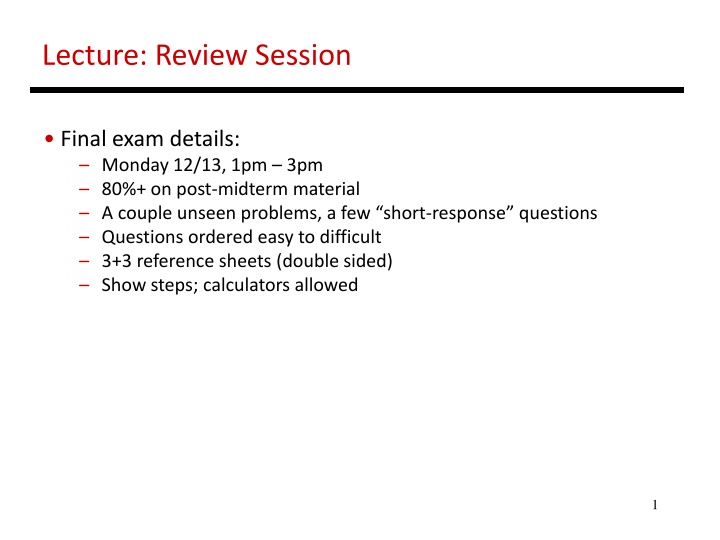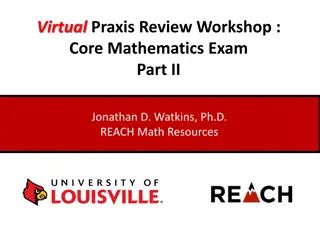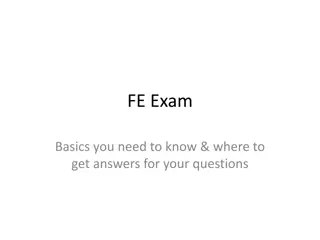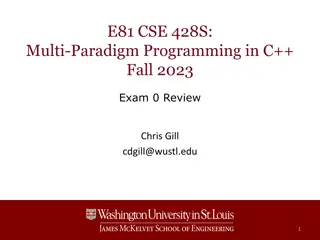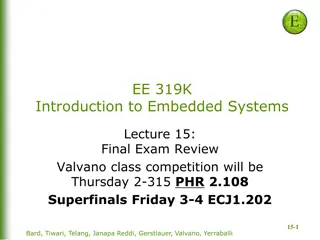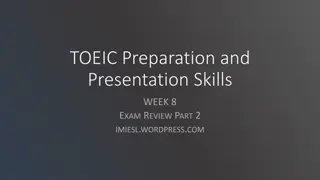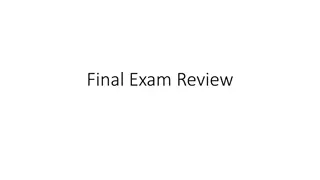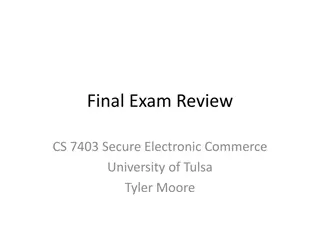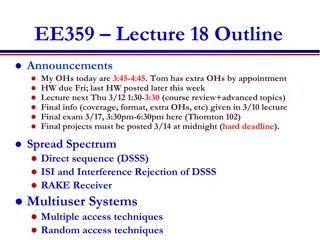Comprehensive Review Session for Final Exam Details
Final exam details for a lecture review session happening on Monday, 12/13 from 1 pm to 3 pm have been provided. The exam will focus on post-midterm material with a few unseen problems and short-response questions. Students will need to show steps, and calculators are allowed. Topics covered include memory access times, cache configurations, and addressing calculations in a structured manner.
Download Presentation

Please find below an Image/Link to download the presentation.
The content on the website is provided AS IS for your information and personal use only. It may not be sold, licensed, or shared on other websites without obtaining consent from the author.If you encounter any issues during the download, it is possible that the publisher has removed the file from their server.
You are allowed to download the files provided on this website for personal or commercial use, subject to the condition that they are used lawfully. All files are the property of their respective owners.
The content on the website is provided AS IS for your information and personal use only. It may not be sold, licensed, or shared on other websites without obtaining consent from the author.
E N D
Presentation Transcript
Lecture: Review Session Final exam details: Monday 12/13, 1pm 3pm 80%+ on post-midterm material A couple unseen problems, a few short-response questions Questions ordered easy to difficult 3+3 reference sheets (double sided) Show steps; calculators allowed 1
Problem 4 Consider the following LSQ and when operands are available. Estimate when the address calculation and memory accesses happen for each ld/st. Assume memory dependence prediction. Ad. Op St. Op Ad.Val Ad.Cal Mem.Acc LD R1 [R2] 3 abcd LD R3 [R4] 6 adde ST R5 [R6] 4 7 abba LD R7 [R8] 2 abce ST R9 [R10] 8 3 abba LD R11 [R12] 1 abba 3
Problem 1 Memory access time: Assume a program that has cache access times of 1-cyc (L1), 10-cyc (L2), 30-cyc (L3), and 300-cyc (memory), and MPKIs of 20 (L1), 10 (L2), and 5 (L3). Should you get rid of the L3? With L3: 1000 + 10x20 + 30x10 + 300x5 = 3000 Without L3: 1000 + 10x20 + 10x300 = 4200 4
Problem 3 Assume a 2-way set-associative cache with just 2 sets. Assume that block A maps to set 0, B to 1, C to 0, D to 1, E to 0, and so on. For the following access pattern, estimate the hits and misses: A B B E C C A D B F A E G C G A M MH M MH MM HM HMM M H M 5
Problem 5 8 KB fully-associative data cache array with 64 byte line sizes, assume a 40-bit address How many sets (1) ? How many ways (128) ? How many index bits (0), offset bits (6), tag bits (34) ? How large is the tag array (544 bytes) ? Equations: Data array size (cache size) = #sets x #ways x blocksize Tag array size = #sets x #ways x tagsize Index bits = log2 (#sets) Offset bits = log2 (blocksize) Tag bits + index bits + offset bits = address width 6
Problem 3 Assume that page size is 16KB and cache block size is 32 B. If I want to implement a virtually indexed physically tagged L1 cache, what is the largest direct-mapped L1 that I can implement? What is the largest 2-way cache that I can implement? 7
HW 7, Q1 Assume a large shared LLC that is tiled and distributed on the chip. Assume that the OS page size is 16KB. The entire LLC has a size of 32 MB, uses 64-byte blocks, and is 32-way set-associative. What is the maximum number of tiles such that the OS has full flexibility in placing a page in a tile of its choosing? 8
Problem 1 What is the maximum memory capacity supported by the following server: 2 processor sockets, each socket has 4 memory channels, each channel supports 2 dual-ranked DIMMs, and x4 4Gb DRAM chips? 2 sockets x 4 channels x 2 DIMMs x 2 ranks x 16 chips x 4Gb capacity = 256 GB What is the memory bandwidth available to the server if each memory channel runs at 800 MHz? 2 sockets x 4 channels x 800M (cycles per second) x 2 (DDR, hence 2 transfers per cycle) x 64 (bits per transfer) = 102.4 GB/s 9
Problem 4 For the following access stream, estimate the finish times for each access with the following scheduling policies: Req Time of arrival Open Closed Oracular X 10 ns 50 50 50 X+1 15 ns 70 70 70 Y 100 ns 160 140 140 Y+1 180 ns 200 220 200 X+2 190 ns 260 300 260 Y+2 205 ns 320 240 320 Note that X, X+1, X+2, X+3 map to the same row and Y, Y+1 map to a different row in the same bank. Ignore bus and queuing latencies. The bank is precharged at the start. ** A more sophisticated oracle can do even better. 10
Problem 5 Consider a single 4 GB memory rank that has 8 banks. Each row in a bank has a capacity of 8KB. On average, it takes 40ns to refresh one row. Assume that all 8 banks can be refreshed in parallel. For what fraction of time will this rank be unavailable? How many rows are refreshed with every refresh command? The memory has 4GB/8KB = 512K rows There are 8K refresh operations in one 64ms interval. Each refresh operation must handle 512K/8K = 64 rows Each bank must handle 8 rows One refresh operation is issued every 7.8us and the memory is unavailable for 320ns, i.e., for 4% of time. 11
Meltdown Attacker code Fill the cache with your own data X lw R1 [illegal address] lw [R1] Scan through X and record time per access 12
Spectre: Variant 1 x is controlled by attacker Thanks to bpred, x can be anything array1[ ] is the secret if (x < array1_size) y = array2[ array1[x] ]; Victim Code Access pattern of array2[ ] betrays the secret 13
Spectre: Variant 2 Victim code R1 (from attacker) R2 some secret Label0: if ( ) Attacker code Label0: if (1) Label1: Victim code Label1: lw [R2] 14
Snooping Example Request Cache Hit/Miss Request on the bus Who responds State in Cache 1 State in Cache 2 State in Cache 3 State in Cache 4 Inv Inv Inv Inv P1: Rd X Miss Rd X Memory S Inv Inv Inv P2: Rd X Miss Rd X Memory S S Inv Inv P2: Wr X Perms Miss Upgrade X No response. Other caches invalidate. Inv M Inv Inv P3: Wr X Write Miss Wr X P2 responds Inv Inv M Inv P3: Rd X Read Hit - - Inv Inv M Inv P4: Rd X Read Miss Rd X P3 responds. Mem wrtbk Inv Inv S S 15
Directory Example Request Cache Hit/Miss Messages Dir State State in C1 State in C2 State in C3 State in C4 Inv Inv Inv Inv P1: Rd X Miss Rd-req to Dir. Dir responds. X: S: 1 S Inv Inv Inv P2: Rd X Miss Rd-req to Dir. Dir responds. X: S: 1, 2 S S Inv Inv P2: Wr X Perms Miss Upgr-req to Dir. Dir sends INV to P1. P1 sends ACK to Dir. Dir grants perms to P2. X: M: 2 Inv M Inv Inv P3: Wr X Write Miss Wr-req to Dir. Dir fwds request to P2. P2 sends data to Dir. Dir sends data to P3. X: M: 3 Inv Inv M Inv P3: Rd X Read Hit - - Inv Inv M Inv P4: Rd X Read Miss Rd-req to Dir. Dir fwds request to P3. P3 sends data to Dir. Memory wrtbk. Dir sends data to P4. X: S: 3, 4 Inv Inv S S 16
Test-and-Test-and-Set lock: test register, location bnz register, lock t&s register, location bnz register, lock CS st location, #0 17
Spin Lock with Low Coherence Traffic lockit: LL R2, 0(R1) ; load linked, generates no coherence traffic BNEZ R2, lockit ; not available, keep spinning DADDUI R2, R0, #1 ; put value 1 in R2 SC R2, 0(R1) ; store-conditional succeeds if no one ; updated the lock since the last LL BEQZ R2, lockit ; confirm that SC succeeded, else keep trying If there are i processes waiting for the lock, how many bus transactions happen? 1 write by the releaser + i (or 1) read-miss requests + i (or 1) responses + 1 write by acquirer + 0 (i-1 failed SCs) + i-1 (or 1) read-miss requests + i-1 (or 1) responses (The i/i-1 read misses can be reduced to 1) 18
Example Programs Initially, A = B = 0 Initially, Head = Data = 0 P1 P2 Data = 2000 while (Head == 0) Head = 1 { } = Data P1 P2 A = 1 B = 1 if (B == 0) if (A == 0) critical section critical section Initially, A = B = 0 P1 P2 P3 A = 1 if (A == 1) B = 1 if (B == 1) register = A 19
Problem 1 What are possible outputs for the program below? Assume x=y=0 at the start of the program Thread 1 Thread 2 A x = 10 a y=20 B y = x+y b x = y+x C Print y Possible scenarios: 5 choose 2 = 10 ABCab ABaCb ABabC AaBCb AaBbC 10 20 20 30 30 AabBC aABCb aABbC aAbBC abABC 50 30 30 50 30 20
Fences P1 P2 { { Region of code Region of code with no races with no races } } Fence Fence Acquire_lock Acquire_lock Fence Fence { { Racy code Racy code } } Fence Fence Release_lock Release_lock Fence Fence 21
Deadlock Deadlock happens when there is a cycle of resource dependencies a process holds on to a resource (A) and attempts to acquire another resource (B) A is not relinquished until B is acquired 22
Topology Examples Hypercube Grid Torus Criteria 64 nodes Bus Ring 2Dtorus Hypercube Fully connected Performance Diameter Bisection BW 1 1 32 2 8 16 6 32 1 1024 Cost Ports/switch Total links 3 64 5 7 64 2016 23 1 128 192
k-ary d-Cube Consider a k-ary d-cube: a d-dimension array with k elements in each dimension, there are links between elements that differ in one dimension by 1 (mod k) Number of nodes N = kd Number of switches : Switch degree : Number of links : Pins per node : N 2d + 1 Nd 2wd Avg. routing distance: Diameter : Bisection bandwidth : Switch complexity : d(k-1)/4 d(k-1)/2 2wkd-1 (2d + 1)2 The switch degree, num links, pins per node, bisection bw for a hypercube are half of what is listed above (diam and avg routing distance are twice, switch complexity is ) because unlike the other cases, a hypercube does not have right and left neighbors. (d + 1)2 24 Should we minimize or maximize dimension?
Problem 1 Assume that a server consumes 100W at peak utilization and 50W at zero utilization. Assume a linear relationship between utilization and power. The server is capable of executing many threads in parallel. Assume that a single thread utilizes 25% of all server resources (functional units, caches, memory capacity, memory bandwidth, etc.). What is the total power dissipation when executing 99 threads on a collection of these servers, such that performance and energy are close to optimal? For near-optimal performance and energy, use 25 servers. 24 servers at 100% utilization, executing 96 threads, consuming 2400W. The 25th server will run the last 3 threads and consume 87.5~W. 25
RAID 4 and RAID 5 Data is block interleaved this allows us to get all our data from a single disk on a read in case of a disk error, read all 9 disks Block interleaving reduces thruput for a single request (as only a single disk drive is servicing the request), but improves task-level parallelism as other disk drives are free to service other requests On a write, we access the disk that stores the data and the parity disk parity information can be updated simply by checking if the new data differs from the old data 26
TPU Architecture 8 GB 256 KB 24 MB Weights are pre-loaded during previous phase and inputs flow left to right. 28
